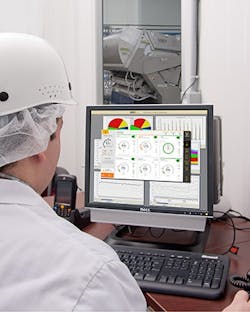When something goes wrong with equipment, it always helps to call an expert. Now the experts can call the equipment.
Remote monitoring and control is increasingly an option for all types of equipment. With the advent of the Industrial Internet of Things (IIoT), data can flow on a nearly continuous basis from a plant to any location. Experts, from a machine’s original manufacturer or elsewhere, can tap into its output and readings to determine possible sources of problems and suggest solutions. It can significantly advance the speed and timeliness of maintenance.
“We have become a 24-hour society where companies, especially those in food & beverage, are striving to avoid downtime of machines because it directly affects the bottom line,” says Maggie Slowik, global industry director of manufacturing for industrial software supplier IFS. “Linked to this, production managers as well as CEOs want to be able to monitor to their plants around the world.”
The IIoT opens up new vistas for remote equipment monitoring, but it’s not necessary for equipment to have IIoT connections to benefit from it.
“Any equipment that is capable of an external connection through a PC or PLC has this capability,” says Ron Shiedler, principal controls engineer at Concept Systems, a member of the Control System Integrators Assn. (CSIA). The key is that the equipment has to be on the same network with a monitoring device.
The latter could be any kind of computer – a laptop, tablet or smartphone – that is connected to the equipment manufacturer or whomever is trying to help. In some cases, this can be done with a simple hard-wire or wireless connection; in others, it’s advantageous to set up a virtual private network (VPN), a secure, encrypted connection that encompasses a select part of the plant’s overall network.
Some applications don’t even require a direct connection to machinery. Certain kinds of sensors and probes can attach extraneously to equipment and send data wirelessly, usually to an in-plant server or router that funnels it to a third party for evaluation.
Mining the data
Remote services can run the gamut of maintenance operations, from routine to predictive to troubleshooting. One of their biggest advantages is that they can perform full, continual analysis on the stream of data they receive.
This is especially important for situations where the correct parameters for metrics like temperature or vibration are not precisely known. When that’s the case, it becomes impossible to set limits for things like alarms and notifications. If the limit is set too low, it will lead to some potentially harmful conditions being missed; too high and false alarms will render the system useless. By bringing artificial intelligence (AI) to bear on the data, software hosted by the evaluating company can pinpoint the correct parameters.
A service like that is particularly useful with parameters that are tricky to set. Vibration, in particular, can be affected by many environmental factors. It’s best to have parameters for vibration alarms set by specialists who can analyze data streams from sensors, often bringing in some AI. Remote access is a good way to expedite that scenario.
CSIA member Sensata Technologies has a multi-modal sensor for rotary equipment that measures vibration, as well as temperature and acoustic emission. “The system will learn the baselines for that asset and then use data from all those modalities concurrently to identify issues such as bearing problems, looseness, unbalance and more,” says Paul Heine, IIoT product manager. “At the same time, it will calculate the asset’s remaining useful life, allowing plant managers to better prioritize parts ordering and maintenance schedules during planned downtime events.”
More generally, a constant stream of data, continually evaluated, can form the basis for a predictive maintenance program. Predictive maintenance is more cost-effective than preventive maintenance done according to a set schedule, because it delays action until a piece of equipment genuinely needs it.
Under a predictive maintenance program, “reliability engineers and maintenance teams can prevent asset failure before it happens and use the health of assets to refine and update maintenance plans to work on assets that need to be worked on at the right time, and not sooner or too late,” says James Newman, head of product and portfolio marketing at Augury, a provider of diagnostic services.
Remote diagnostics helps equipment like the Veryx sorter from Key Technology maintain accuracy at high speeds.
Network upgrades
Remote access also can be used to conduct software upgrades, allowing all the equipment on a network to be upgraded at the same time. In some cases, a deeper dive into a machine’s overall condition can be accomplished remotely, says Marco Azzaretti, director of marketing at Key Technology, a supplier of sorting and material handling equipment.
“Remote equipment connectivity allows us to perform extensive on-line audits of the sorter’s condition and the health of its components,” Azzaretti says. “For example, a remote audit prior to the start of a new [produce] season ensures the equipment is fully ready to begin production.”
However, the great majority of food & beverage processors who use remote monitoring do so to expedite troubleshooting. There’s nothing like giving an expert a direct look at a problem.
“Troubleshooting an issue is the most valuable benefit of having a remote connection,” says Abe Smith, senior engineer at Concept Systems. “A one-hour support call could take less than 15 minutes if we have a direct view of the HMI [human-machine interface] and PLC program.”
An example of a problem dealt with remotely occurred at a large food manufacturer’s plant. Its clean-in-place system was not working properly in a particular application; traces of one flavor were turning up in the next batch of a different flavor. CSIA member Process and Data Automation, a division of Krones, was able to diagnose the problem through a remote connection. The CIP process was altered, with changes to strainers, more time added to the prerinse cycle and more water to the batch rinse.
Security issues
One of the biggest reasons food & beverage companies hesitate to use remote equipment access is security concerns. As cyberattacks against food & beverage companies mount, many are reluctant to add additional points of vulnerability to their operations.
One of the best ways to make connections more secure is to set them up as a virtual private network (VPN), which has security advantages as well as being a good option for more complex types of remote access. Other good security practices include: using two-factor authentication, such as having a code sent to a user’s phone or other device; allowing access only at specific dates and times, with a one-time security certificate issued for each occurrence; and using a vendor with sophisticated security procedures.
Matrix Packaging Machinery uses encrypted MQTT connections to enhance security of its remote connections.
For example, Matrix Packaging Machinery, a supplier of bag filling equipment, uses encrypted MQTT connections as an alternative to VPNs. MQTT is a communication protocol designed especially for machinery. Its advantage is that it allows for a “narrow” linkup between Matrix and the equipment’s MQTT connection, as opposed to connecting to the machine user’s network as a whole.
“This prevents IT from needing to put a ‘hole’ in their secure network for us. This helps keep unauthorized personnel off their network,” says Cory Tollefsrud, a Matrix controls engineer. In addition, since it’s a single outgoing port, the plant’s IT department doesn’t have to modify its firewall settings to accommodate the connection, Tollefsrud says.
Remote monitoring can open up new vistas in maintenance. If done properly, it can greatly enhance machine maintenance and troubleshooting without compromising security.




